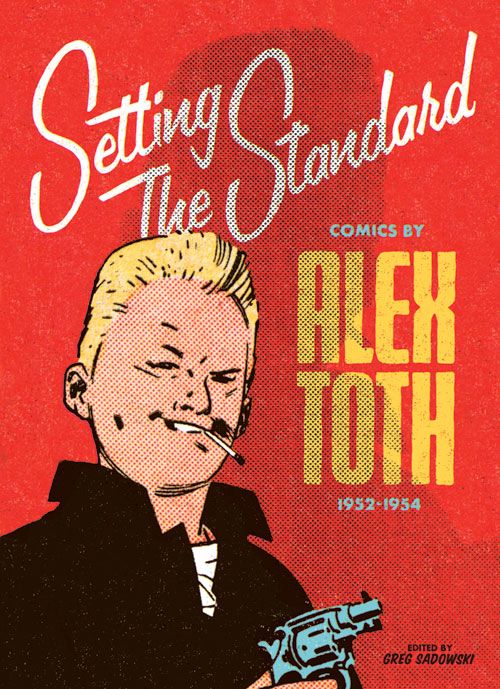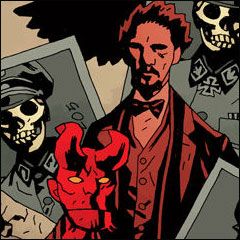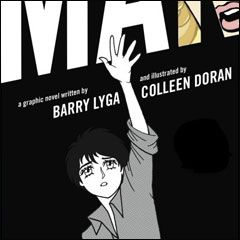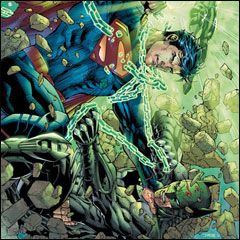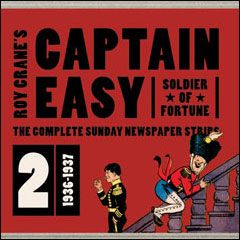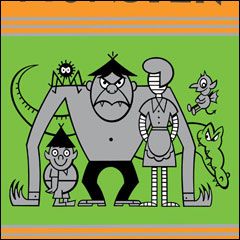Welcome to What Are You Reading?, where each week we talk about what comics, graphic novels, books and what-have-you we've been reading lately. This week our special guest is Brian Ralph, creator of Daybreak, Cave-In and Reggie 12.
To see what Brian and the Robot 6 crew have been reading lately, click below.
*****
Michael May
I almost got caught up on BPRD last Halloween – pretty much from the beginning of the series – and it was an excellent way to spend October. I think I’m going to make a tradition out of it: catching up on the last year’s worth of BPRD stories this time each year. This week, I picked up where I left off with Volume 13, BPRD: 1947. I don’t know why Gabriel Bá and Fábio Moon hadn’t done a Hellboy story before this one, but I’m not complaining. It was worth waiting for. Especially using their different styles to depict two different worlds: sometimes figuratively; sometimes literally.
My favorite part of the book though comes at the very end when Trevor Bruttenholm’s debriefing about the adventure with a colleague. The last several hours have been harrowing and Bruttenholm’s been ignoring young Hellboy because he's distracted by the very dangerous case. As he and his friend – a former Catholic priest – talk, his elderly companion makes an observation about the nature of religion as the panels pan around Bruttenholm’s office, focusing on his diverse collection of idols and fetishes. “Man has given a thousand different names to his God,” the priest says, “but look into the face of each one long enough and hard enough – you will find one Truth.”
The old man doesn’t say what it is and I’m not enough of a religion scholar to know what he meant for sure, but my personal belief is that God – however people think of him – is all about our being good to each other. I was thrilled to see that idea born out in the story. The priest seems to imply that Bruttenholm should destroy the demonic Hellboy while he can, but the professor instead goes out and plays catch with the child he’s been neglecting. It’s a beautiful moment, made more touching by the knowledge of how Bruttenholm’s love for his “son” will eventually overcome Hellboy’s supernatural programming towards evil. This kind of stuff is why Mike Mignola and Company’s comics are the best damn ones on the shelves.
Brigid Alverson
Barry Lyga and Colleen Doran's Mangaman is like the novelization of Scott McCloud's Understanding Comics. It's the story of a manga character, Ryoko, who gets pulled through a rip in the universe to an ordinary American town, where he is sent to an ordinary American high school. The catch is that Ryoko retains his manga characteristics—speed lines appear when he is excited, then drop to the ground for the janitor to sweep up, people he is thinking about appear in the panel, and his eyes turn into hearts when he sees the lovely Marissa, the homecoming queen who is dissatisfied with her life and shows up every day in a different costume. On the one hand, it's the traditional story of a stranger in a strange land, but on the other hand, it's a metafictional meditation on the comics medium. Either way, it's laugh-out-loud funny in places and a great read.
In a much more traditional vein, Psyren, the latest manga in Viz's Shonen Jump line, is a fairly standard shonen manga story about a tough guy (with a heart of gold) who is thrust into a series of challenges. Ageha starts off the book by beating up a bunch of gang members, so you know he's badass, but he has a soft spot in his heart for the bespectacled Sakurako, who was a childhood friend. So when Sakurako disappears, and Ageha realizes it has something to do with a shadowy organization that recruits people with phone cards, he jumps right in and winds up fighting off killer arthropod robots in a desolate landscape. There's nothing in this first volume that I haven't seen before in some other manga, but it's well drawn and a good read, so no complaints.
Tim O'Shea
Justice League #2: Not sure which plot point annoyed me more. When Green Lantern and Batman whispered in the heat of battle, so the guy with super-hearing could not hear them. Um, right. Or maybe a Hal Jordan/Green Lantern so new to the secret identity aspect, he says Flash’s first name (when expressing concern that Flash had revealed an aspect of his secret identity by telling Batman he worked in a crime lab). I’m done with this title.
Birds of Prey #2: Trying to do a book like this in the new DC universe (one without Oracle) is a challenge. But I think writer Duane Swierczynski has found the right cast member replacement (for Oracle) with Starling in the role of Black Canary confidant. I am intrigued to see how Katana (who joined the cast in this issue, along with someone else) changes up the mix. I’ll be back for issue #3.
Herc #9: This series has already been cancelled, but I cannot help but continue to buy it as this series in particular allows the writing team of Greg Pak and Fred Van Lente to indulge their comedic tendencies. It’s a fun read, but sadly not one that attracted enough readership. This issue in particular allows for some hilarious bits between Herc and his dad, Zeus.
Nightwing #2: I am pleased with writer Kyle Higgins’ repurposing of the Haly Circus for this new series. In rebooting the DC universe, I am glad they did not majorly revamp the Batfamily. Dick Grayson remains one of my favorite characters in the DCU, new or old. In general, I wish there were more heroes that smiled more often, like Nightwing.
Batman #2: Depending on how this first arc plays out, I may proclaim Batman to be one of my favorite new DC titles to date. Some people have grown tired of the story device where the reader is thrown into the middle of the plot and then brought back to that point via flashback (hell I am confused trying to describe it). But that plot device worked really well in this issue. As much as I enjoy writer Scott Snyder, artist Greg Capullo is the one that sells the kineticism that ripples through this issue’s action.
Brian Ralph
Roy Crane's Captain Easy Vol. 2. (Fantagraphics)
I absolutely fell in love with volume one when it came out. These were comics people had recommended to me over the years, but I had only caught glimpses of it until that first volume came out. It did not disappoint! Roy Crane draws these huge adventure strips featuring a soldier-of-fortune, Captain Easy. He wanders the globe helping dames and punching out goons and villains. It's a fun combination of action and laughs. Sometimes very serious and other times very cartoony, in both story and art style. I just love the way Roy Crane draws these goons.
And the colors! The palettes are unusual and beautiful. A comic artist could just go through here and steal these lively color palettes. Volume 2 is a little more goofy than Volume 1, the stories seem a little less urgent. But I still love it.
The books are also really beautifully designed and very nicely packaged.
Lynd Ward: Six Novels in Woodcuts. (The Library of America)
I received this box set for my birthday. This is a collection of 6 stories by Lynd Ward and has a forward by Art Spiegelman.
Originally I had discovered Lynd Ward and these early silent woodcut graphic novels while I was rooting around in the RISD library as a student. I became very interested in them. I took up scratchboard as a way of imitating the woodcut look. It taught me a lot about working in black and white. By looking at these stories I learned how to unlock that puzzle of placing areas of white next to dense black to create vivid and rich imagery.
When you think about it, woodcuts are such a laborious process and yet these stories seem really fresh and lively.
It's a handsome box set, and you'll look like a real smarty for having it on your shelf. That is, if people ever come over your house.
Melvin Monster: John Stanley Library. (D+Q)
Actually my seven-year-old son Miles has been reading this, along with the other books in the John Stanley library. (Even "Tubby" has his own book now!)
The Melvin Monster series features this good-hearted little monster kid, who despite being a monster wants to do good things. This frustrates his Frankenstein Dad and his Mummy Mom. His "Baddy" Dad wants him to do bad stuff! I think my son likes it because it's kind of edgy and twisted at times. They are beautiful books of course, nice hardcovers, real rough-and-tumble style for the kids. I imagine someday passing these down to my grand kids.
These books are engaging to Miles, he'll sit there giggling and reading, and Dad can get some "Me" time.
Setting the Standard: Comics by Alex Toth 1952-1954 (Fantagraphics)
These are short comics by Alex Toth, quick 3-4 pagers that would appear in comics like "Thrilling Romance" or "Crime Files" in the 50's.
I'll read one of these before I go to bed. I like that in a short page count he quickly develops a rich story and twilight zoney twist. Sometimes it's a bizarre romance or horror story with a stunning conclusion. They're a fun read.
The art! Alex Toth really did some cool things with chiaroscuro. And the panel compositions are really unique and interesting. He did some dramatic and unexpected things with the arrangement of the characters and the still-life elements. It's inspiring. I think all cartoonists should pick this up and borrow some ideas from Alex Toth.
Cartooning: Philosophy and Practice. Ivan Brunetti (Yale University Press)
This originally came out a few years ago, but it's been recently republished. I love this little book. Ivan presents a class on cartooning, but I think his approach is very unique. The tone of the book is kind of conversational and informal, like you are actually in Ivan's class. I recommend this book to my students, but I'd always recommend it to anyone who is interested in comics and cartoons and the thought process that goes into putting them together. It fits nicely in your pocket.


